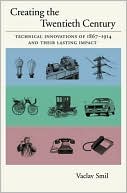

 |

|

The average rating for Creating the 20th Century, Vol. 1 based on 2 reviews is 3 stars.
Review # 1 was written on 2014-03-16 00:00:00 Eric Zink Eric ZinkI have very mixed feelings about this very absorbing book about the development of electric power transmission, internal combustion motors, new chemical processes, and telephone and radio in the period from 1865 to 1914. Smil is a great story-teller, weaving in technical details about the individual inventions with the broader picture of overwhelming and rapid technological change. (But he assumes a fairly high level of technical knowledge going in -- for example he gives a great explanation of the Otto cycle in a normal gasoline engine, then doesn't give any description of the combustion cycle in a Diesel engine. Keep Wikipedia handy.) Smil demolishes the image of Edison and other inventors as brilliant geniuses who created their invention through tinkering. He shows that the technical innovations of this time were grounded in a revolution in science, and that scientific theory often preceded the development of new inventions. One of the markers Smil gives for this "Age of Synergy" is the publication of Capital in 1867, " a muddled but extraordinarily influential piece of ideological writing." But I actually think Capital is a great companion volume to this book, or this book to Capital. Capital places these extraordinary changes in the context of the development of the accumulation process. The drive for accumulation pushed capitalists to increase the productivity of labor (electric motors, electric lighting, steam turbines), create new products (new fertilizers thru the Haber process), and speed up global transportation and communication (the internal combustion engine, telephone, radio). Smil hints at these connections all over place, like when he describes how electricity and the electric motor revolutionized factory production and increased the flexibility of production design by eliminating steam-driven belts. I left this book wanting to read more Smil. |
Review # 2 was written on 2018-03-24 00:00:00 Kristina S. Langan Kristina S. LanganThis book is aimed perfectly by the author, to proclaim the special debt we owe to the period of technical innovation from 1880 to 1940 that gave us electricity, engines, radio, and film. But the writing style is very bad. It reads like someone is summarizing other books they have read. Information is duplicated many times because the author could not synthesize his sources into a coherent narrative. I also wish the author had spent some pages to compare this age of innovation with out modern age of computers, data, and satellites. |
CAN'T FIND WHAT YOU'RE LOOKING FOR? CLICK HERE!!!